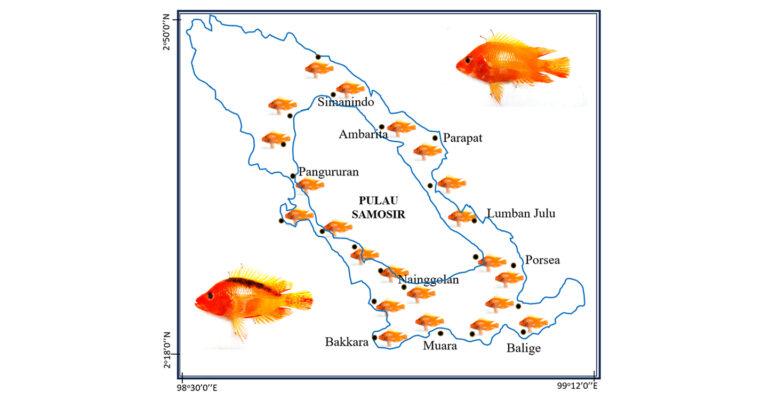IPB University’s Dosen Pulang Kampung Programm Studies the Distribution Invasive Red Devil Invasive Fish Population in Lake Toba

A team of IPB University lecturers from the Faculty of Fisheries and Marine Science (FPIK) through the Dosen Pulang Kampung (Dospulkam) program conducted research on the distribution and abundance of the invasive red devil or tayo-tayo fish population in Lake Toba waters. The research took place from April to October 2024. The team of lecturers consisted of Prof Jonson Lumban-Gaol, Dr Charles P H Simanjuntak, Prof Vincentius V Siregar, and Dr Dinar Tri Soelistyowati.
One of the IPB University lecturers, Dr Charles Simanjuntak, said this research was carried out as an initial effort to control the red devil fish population which is suspected to have spread widely in almost all waters of Lake Toba. He said that the explosion of the red devil population had disturbed the fishing community on the outskirts of Lake Toba.
“We conducted a survey of red devil fish distribution in the waters of Lake Toba, covering five districts namely Toba, North Tapanuli, Humbang Hasundutan, and Simalungun,” said Dr Charles.
The IPB University lecturer explained that the fish found during the survey consisted of seven species from five families. The most abundant and dominant fish found in all sampling locations is red devil fish (Amphilophus citrinellus) of various sizes.
“Our findings indicate that red devil fish, which is actually not a native fish (alien species) of Lake Toba because it comes from Nicaragua, has been able to develop its population massively in the waters of Lake Toba,” said Dr Charles, an Ichthyologist from FPIK IPB University.
During this research, the Dospulkam IPB University team also found fish species native to Lake Toba such as Batak fish (Neolissochilus soro) and manggabai fish (Glossogobius giuris). One species of fish that was once a favorite in the 2003-2013 period, namely Mystacoleucus padangensis or also known as pora-pora fish, was successfully found in several tributaries (Lake Toba inlet). In fact, this fish was considered extinct in Lake Toba since 2016.
According to Dr Charles, the abundant and widespread red devil fish in the waters of Lake Toba is due to several reasons, such as the absence of natural predators of this species in Lake Toba that control the red devil fish population. He also mentioned that red devil fish are omnivorous and tend to be carnivorous, so they can utilize all available food niches. In fact, he said, this species was found to consume the fingerlings of other species.
“Red devil fish are aggressive, establish territories, guard their nests, and spawn throughout the year. As a result, the recruitment of this fish is very fast. In addition, people around Lake Toba are not very fond of this fish because of its sharp spines and thin meat, so it is mostly caught for animal feed,” said Dr Charles.
Until now, he continued, the utilization of red devil fish as food ingredients in the form of processed products such as fish balls and fish crackers is still very limited. This has driven the population growth rate of red devil fish, which continues to climb due to the lack of fishing effort for daily use.
Dr Charles said this research is still a preliminary study. “We have designed the next study which will not only focus on the bioecological aspects of red devil fish, but we will also conduct a study of red devil fish population control, interactions between fish populations currently inhabiting Lake Toba, and the use of red devil fish to increase the income of fishing communities around Lake Toba.”
“We see that red devil fish can be utilized as a food source of animal protein to reduce the stunting rate of children around Lake Toba,” said Dr Charles. (*/ra) (IAAS/RUM)



